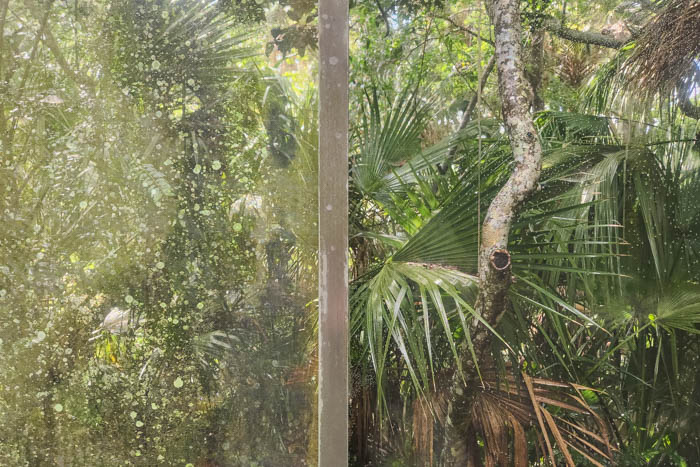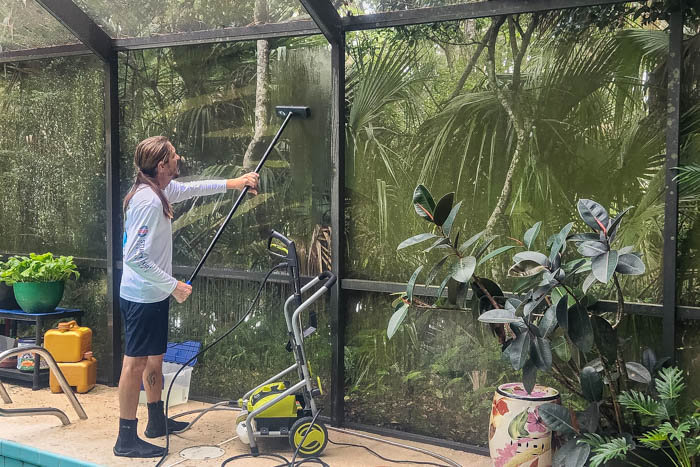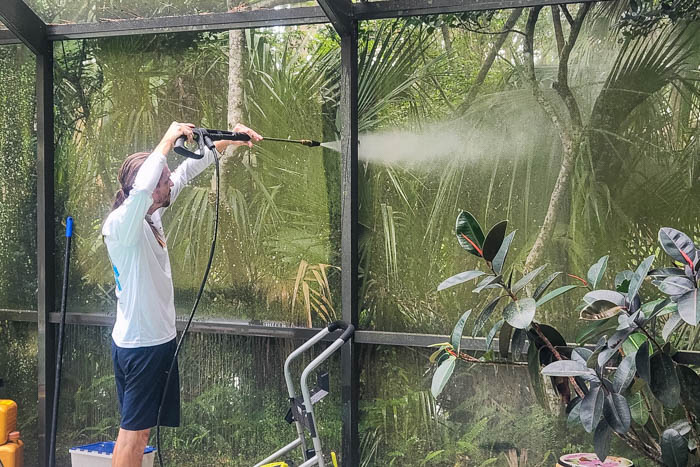Having a pool enclosure is a great feature because it blocks harmful UV rays, and it prevents debris and bugs from getting into your pool. The drawback is that they can get pretty dirty. Let’s look at the quickest ways to clean pool cage screens.

Article Contents
Best Ways to Clean Pool Cage Screens & Enclosures
1. Use a mild soap and water solution
A simple solution of soap, like Dawn dish soap, and warm water is the most common and useful way to clean almost anything off of a pool enclosure. Mix ¼ soap with ¾ water in a cleaning bucket, and you’re good to go.
The detergent is strong enough to remove stubborn grime and caked-on dirt but is gentle enough not to damage any of the pool’s equipment and is not harmful to your skin. It is also safe for the environment.
2. With a vinegar solution
A 50/50 solution of vinegar and warm water is an effective cleaner for pool cages, enclosures, decks, and just about anything else around the pool. It is especially useful for algae and mold as the acidity breaks down the harmful bacteria.

It’s best to use a spray bottle when applying a vinegar solution so that it will cover more area. For stubborn stains, let it sit for a couple of minutes before scrubbing with a soft-bristled brush. Use a pump sprayer if the dirty area is too high to reach (#6).
3. Use an all-purpose cleaner
All-purpose cleaners are okay to use on pool cages if they are not too acidic. I’ve often used Scrubbing Bubbles with great results. Since the bubbles need time to set in, I spray the screen on one side of the pool all the way down and when I’m done spraying, I start cleaning, where I started with a soft-bristled brush.
4. Use a soft-bristled brush
As you can see, a soft-bristled brush is mandatory for whichever cleaner you use. A hard brush will tear the screen, but soft bristles are okay. Be careful how much pressure you use, or you could poke a hole in the screen, especially if it has some age on it. Use the brush with a telescoping pole to reach the higher areas.

5. Use a pump sprayer
This is my go-to equipment for cleaning cage screens. Always wear eye protection while you are spraying because you will have to be looking up to see what you are doing. Pump sprayer nozzles have different strength settings, so use as soft (wide) settings as possible so you don’t blast a hole in the screen. Using a wide spray also allows you to cover more area at once.
Even if I am using a pressure washer, I always add the diluted cleaner to the screen with a pump sprayer. Cleaners and detergents can wear out sprayer and pressure washer hoses over time, and it’s much cheaper to replace pump sprayer parts than on a pressure washer.
6. Use a pressure washer
- Up to 1800 watts of power
- Has 4 quick-connect spray tips
- Cleans tar, grease, oil stains, rust, and other stubborn gunk and grime
Finally, a pressure washer will be your best friend if you have a tall enclosure. They can reach further, and you probably won’t need to brush the screen manually. Before you start cleaning, set the pressure washer on the gentlest setting and stand at least 6 feet away from the screen before you spray it. Pressure washers are powerful, and if the setting is too high, it will definitely put a hole in the enclosure.

After you’ve tested the strength, gradually increase the pressure until it is strong enough to clean the screen effectively without damaging it. If the screen has everyday dust and dirt on it, a pressure washer will be enough to clean it. If there are more specialized stains like mold or algae, use one of the detergents listed above in a pump sprayer first.
7. Garden hose with a spray nozzle
Garden hoses generally have enough pressure to reach the top of the enclosure without damaging the screen and are effective. Like with a pressure washer, start on a soft setting at least 6 feet away from the screen before cleaning to ensure it won’t damage the screen.
Tip: After you wash your enclosure with water or any detergent, always test your pool water. Water and detergent runoff could alter the pool’s chemistry.
How to Clean Aluminum Screen Frames
To clean aluminum pool screen frames, use a non-abrasive cleaner. You can also use a pressure washer or soft-bristled brush on its lowest setting. Once the dirt and grime are gone, rinse off the residue with a water hose.
I like to spray a detergent on the frames with a pump-up sprayer, set it for a minute or two, and then clean it with a garden hose. If the spots are stubborn, I’ll use a soft-bristled brush.
How to Clean Spider Webs from Pool Screens
The quickest way to clean spider webs from a pool screen is with a garden hose. The pressure is strong enough to knock down the web and remove webs and dead bugs from the corners of the aluminum poles and the top of the screen. You can also use a cobweb brush (see below).
You can also use the Poolmaster, which is a gentle nylon brush that fits on the end of a telescopic pool pole.
- Removes cobwebs for indoor and outdoor
- Extra-soft bristles
- Wide, dome-shaped head for angled corners
How to Clean Mildew from Pool Screens
The best way to clean mildew from a pool screen or cage is by spraying vinegar on the affected areas first. Then let it set for a couple of minutes. Next, spray it with a pressure washer or garden hose. If the mildew is still there, respray the area and brush it with a soft-bristled brush until the stain is removed.
How to Clean Algae from Pool Screens
Cleaning algae from a pool enclosure screen is the same as cleaning mold. Spray it with vinegar and wash it away with a garden hose or pressure washer. If that doesn’t work, brush the spots away. After removing the algae, monitor the area for a couple of days to ensure it does not return. If it does, repeat the cleaning process.
How to Clean Pollen from Pool Screens
Pollen can be cleaned from a pool screen or cage with a soap and water mixture. Spray the area with a pump sprayer. Next, either wash it away with a hose or pressure washer or brush it away. If any of the pollen lands in your pool, immediately skim the surface and ensure your system is running to flush out any leftover pollen.
Best Brushes to Clean Pool Cage Screens
The only brush you want to use on your screen is nylon. Nylon is durable and will not damage the screen. You also want as straight of a brush as possible to cover more area at once. The Dewfond brush is affordable and dependable.
If you are looking for a telescoping cobweb brush, the Poolmaster is great for reaching hard-to-reach corners. It can also be used on the lanai walls that connect to the screen. An advantage to brushing away cobwebs instead of using water is that you don’t have to worry about altering the pool’s chemistry.
| Image | Product | Features | Link |
|---|---|---|---|
 |
| 9.7 | Check Price |
 |
| 9.5 | Check Price |
Best Cleaning Products to Clean Pool Cage Screens
If you’re looking for a commercial cleaning product, Wet and Forget is a great multi-purpose cleaner for mold, algae, and everyday dirt and grime. It connects to your water hose and can reach the highest areas of your enclosure. It also works great on aluminum frames.
30 second Outdoor Cleaner eliminates hardened stains caused by organic growth in less than a minute. It’s safe for the environment and works wonders on mold and algae stains, even on aluminum frames.
| Image | Product | Features | Link |
|---|---|---|---|
 |
| 9.7 | Check Price |
 |
| 9.5 | Check Price |
Tips to Keep Pool Cage Screens & Enclosures Clean
To keep your enclosure screens clean, spray them with water bi-weekly. Sediment can be hard to see until it accumulates, and then you must use detergents or other means to clean them. Instead, simply hose them down every few weeks so no accumulation builds.
You can also lightly brush them every other rinse cycle. When you do this, make sure also to brush the poles, as they tend to stain easier than screens. You can also do this after heavy rain to avoid wasting water.
If the screens are perpetually dirty, the dirt and grime will run into your pool after heavy rain, which can cause other problems. Keeping your enclosure clean is also healthy for your pool. I recommend washing the enclosure right before you test the water’s chemistry level. That way, if the runoff affects your chemical levels, you can adjust them right away.


